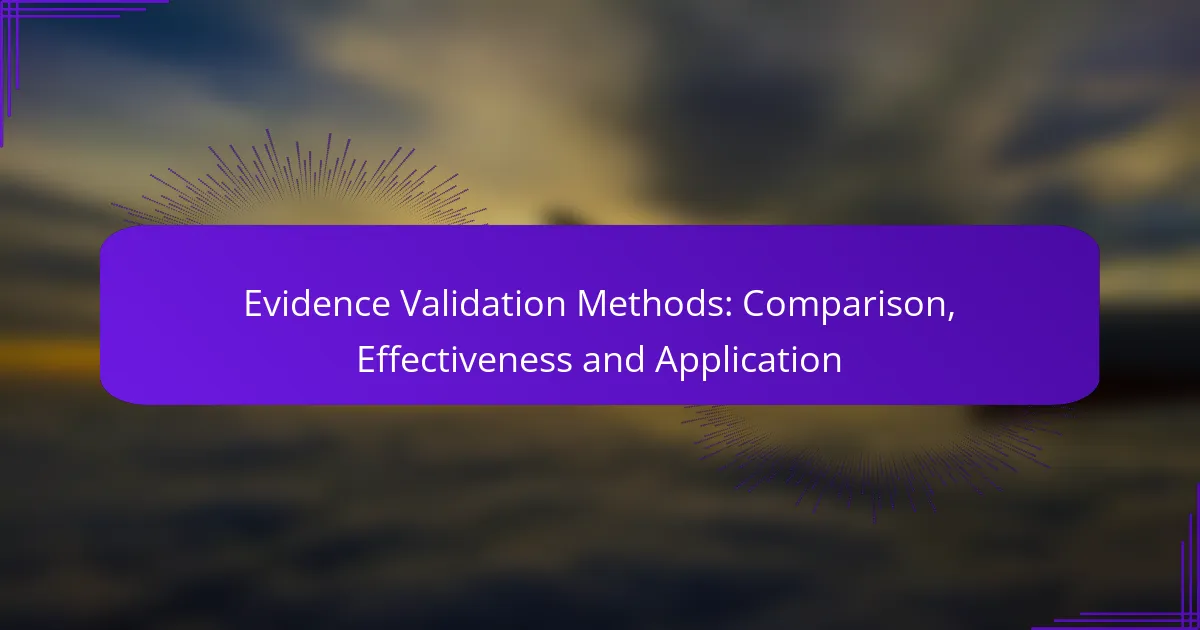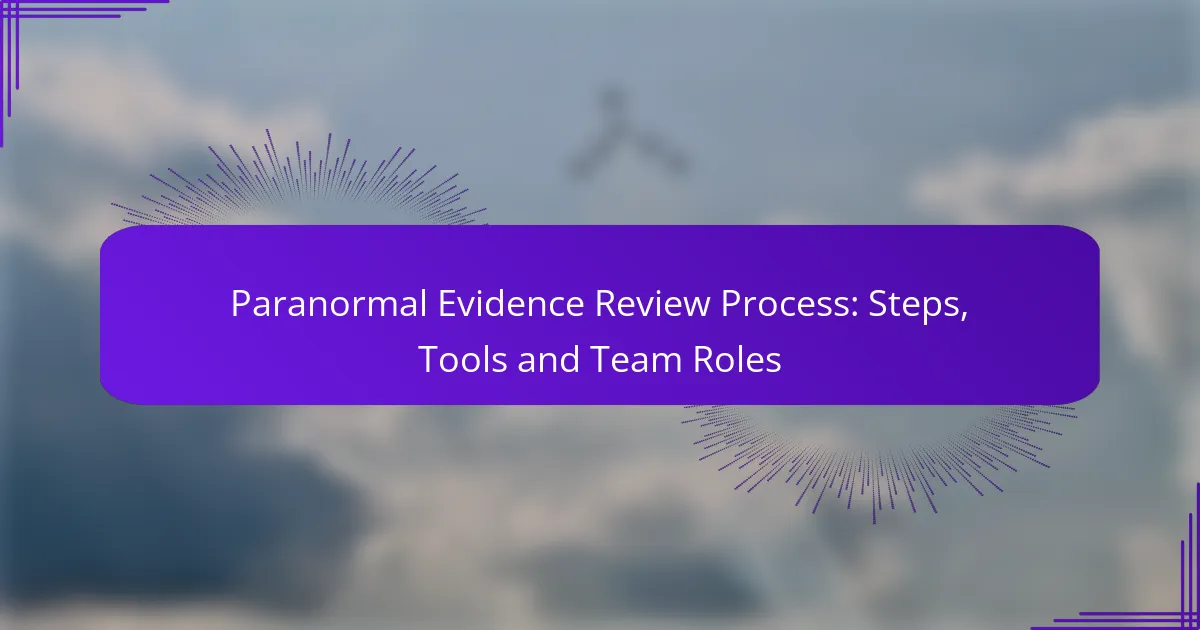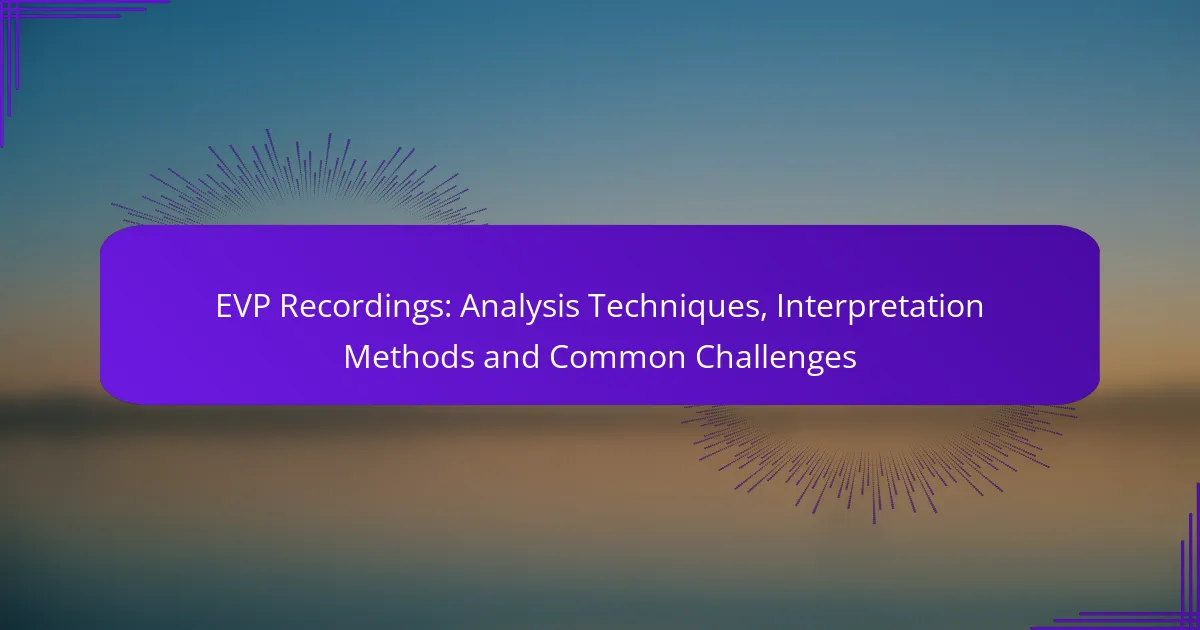Evidence validation methods play a vital role in ensuring the reliability and credibility of data across various fields, including healthcare, policy development, and academic research. By employing techniques such as statistical analysis, peer review, and systematic reviews, researchers can effectively assess the validity of their findings. Understanding the strengths and weaknesses of each method is essential for selecting the most appropriate approach based on specific project needs and contexts.
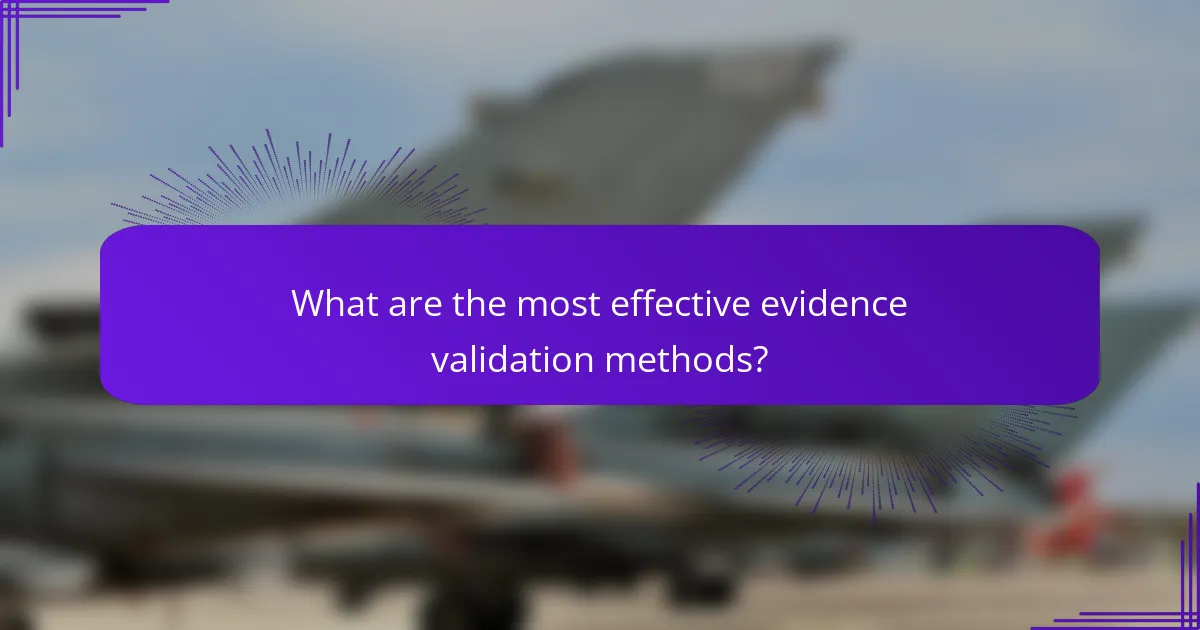
What are the most effective evidence validation methods?
The most effective evidence validation methods include statistical analysis, peer review, meta-analysis, systematic review, and expert consensus. Each method serves a unique purpose in verifying the reliability and relevance of evidence in research and practice.
Statistical analysis
Statistical analysis involves applying mathematical techniques to assess data validity and significance. It helps researchers determine whether observed effects are genuine or due to random chance. Common methods include regression analysis, t-tests, and ANOVA.
When using statistical analysis, consider the sample size and the assumptions underlying each test. A larger sample size typically increases reliability, while violating assumptions can lead to misleading results. Always report confidence intervals and p-values to provide context for your findings.
Peer review
Peer review is a process where experts evaluate research before publication, ensuring quality and credibility. Reviewers assess the methodology, results, and conclusions, providing feedback for improvement. This process is standard in academic journals.
While peer review enhances reliability, it is not foolproof. Some biases may influence reviewers, and not all journals maintain the same standards. Researchers should seek reputable journals with rigorous peer review processes to enhance the validity of their work.
Meta-analysis
Meta-analysis combines data from multiple studies to derive overall conclusions about a particular research question. This method increases statistical power and provides a more comprehensive view of the evidence. It is particularly useful when individual studies yield conflicting results.
When conducting a meta-analysis, ensure that the included studies are comparable in terms of design and population. Consider using forest plots to visualize results and assess heterogeneity among studies. This approach can help identify trends and inform future research directions.
Systematic review
A systematic review is a structured approach to identifying, evaluating, and synthesizing all relevant research on a specific topic. It follows predefined protocols to minimize bias and ensure comprehensive coverage of the literature.
Key steps include formulating a clear research question, establishing inclusion and exclusion criteria, and conducting a thorough literature search. Systematic reviews often culminate in recommendations for practice based on the collective evidence, making them valuable for decision-making.
Expert consensus
Expert consensus involves gathering insights from specialists in a field to establish guidelines or recommendations based on collective knowledge. This method is particularly useful when empirical evidence is limited or emerging.
To achieve expert consensus, consider organizing a Delphi study or a consensus conference. Ensure diverse representation among experts to capture a range of perspectives. While this method can provide valuable insights, be aware that it may be subject to biases inherent in expert opinions.

How do evidence validation methods compare?
Evidence validation methods vary significantly in their effectiveness, accuracy, and application, making it crucial to understand their differences. Each method has its strengths and weaknesses, influencing the choice based on specific project needs and contexts.
Comparison of accuracy
Accuracy in evidence validation methods refers to the degree to which the results reflect the true values or conditions. Methods like systematic reviews and meta-analyses often provide higher accuracy due to their comprehensive nature, while simpler methods may yield less precise results. When selecting a method, consider the trade-off between complexity and the level of accuracy required for your specific application.
For example, qualitative assessments may offer insights but can lack the numerical precision of quantitative methods. Always evaluate the context and the potential impact of inaccuracies on your conclusions.
Comparison of reliability
Reliability measures the consistency of results across repeated applications of the same validation method. Techniques such as randomized controlled trials (RCTs) are generally more reliable due to their structured approach, while observational studies may show variability in outcomes. When assessing reliability, consider the method’s ability to produce stable results under similar conditions.
To enhance reliability, use standardized protocols and ensure adequate sample sizes. This can help mitigate variations and improve the trustworthiness of your findings.
Comparison of cost
The cost of evidence validation methods can vary widely based on the complexity and resources required. For instance, RCTs can be expensive due to the need for extensive planning and participant recruitment, while literature reviews may be more cost-effective but less comprehensive. Budget constraints should guide your choice of method, balancing cost with the quality of evidence needed.
Consider potential hidden costs, such as time spent on training or data collection, which can significantly impact the overall budget. Always perform a cost-benefit analysis before committing to a specific validation approach.
Comparison of time efficiency
Time efficiency refers to how quickly a validation method can produce results. Rapid assessments, like surveys or expert opinions, can yield quick insights but may sacrifice depth. In contrast, methods like systematic reviews can take weeks or months to complete but provide more thorough evaluations.
When time is a critical factor, prioritize methods that align with your deadlines while ensuring they meet the necessary quality standards. Setting clear timelines and milestones can help manage expectations and keep the validation process on track.
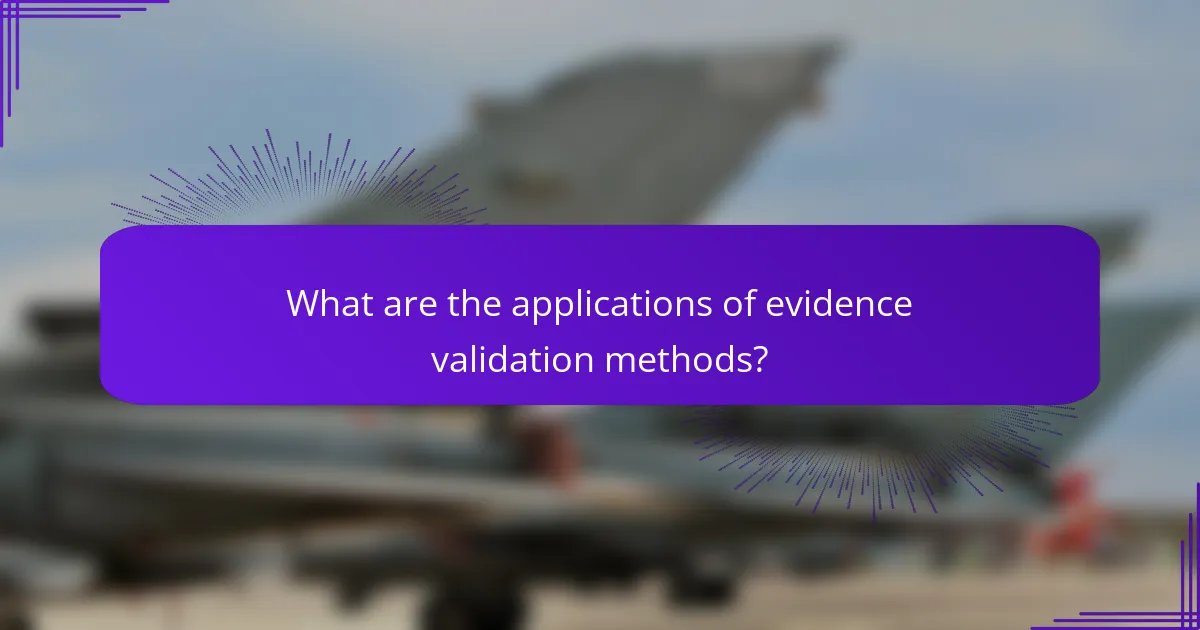
What are the applications of evidence validation methods?
Evidence validation methods are crucial for ensuring the reliability and credibility of data across various fields. These methods are applied in healthcare research, policy development, academic publishing, and market research to enhance decision-making and improve outcomes.
Healthcare research
In healthcare research, evidence validation methods are essential for assessing the effectiveness and safety of treatments. Researchers often use randomized controlled trials and systematic reviews to validate findings, ensuring that conclusions drawn from studies are based on robust evidence.
For example, clinical guidelines often rely on validated evidence to recommend specific therapies, which can significantly impact patient care. Adhering to established protocols and standards, such as those set by the Cochrane Collaboration, can enhance the credibility of research outcomes.
Policy development
Evidence validation methods play a vital role in policy development by providing a foundation for informed decision-making. Policymakers utilize validated data to assess the potential impact of proposed regulations and initiatives, ensuring that policies are based on sound evidence rather than assumptions.
For instance, when developing public health policies, governments may analyze validated studies on disease prevention to allocate resources effectively. Engaging with stakeholders and utilizing evidence from diverse sources can help create more effective and equitable policies.
Academic publishing
In academic publishing, evidence validation methods ensure the integrity and quality of published research. Peer review processes are a common validation method, where experts evaluate the validity of research findings before publication.
Authors must provide robust evidence to support their claims, often including statistical analyses and references to prior validated studies. This rigorous scrutiny helps maintain high standards in scholarly communication and fosters trust in published literature.
Market research
Market research relies on evidence validation methods to ensure that insights and trends are accurate and actionable. Researchers validate data through surveys, focus groups, and analysis of existing market data to provide reliable information to businesses.
For example, companies often use validated consumer feedback to guide product development and marketing strategies. Employing diverse validation techniques, such as triangulation, can enhance the reliability of market insights and reduce the risk of misinformed business decisions.
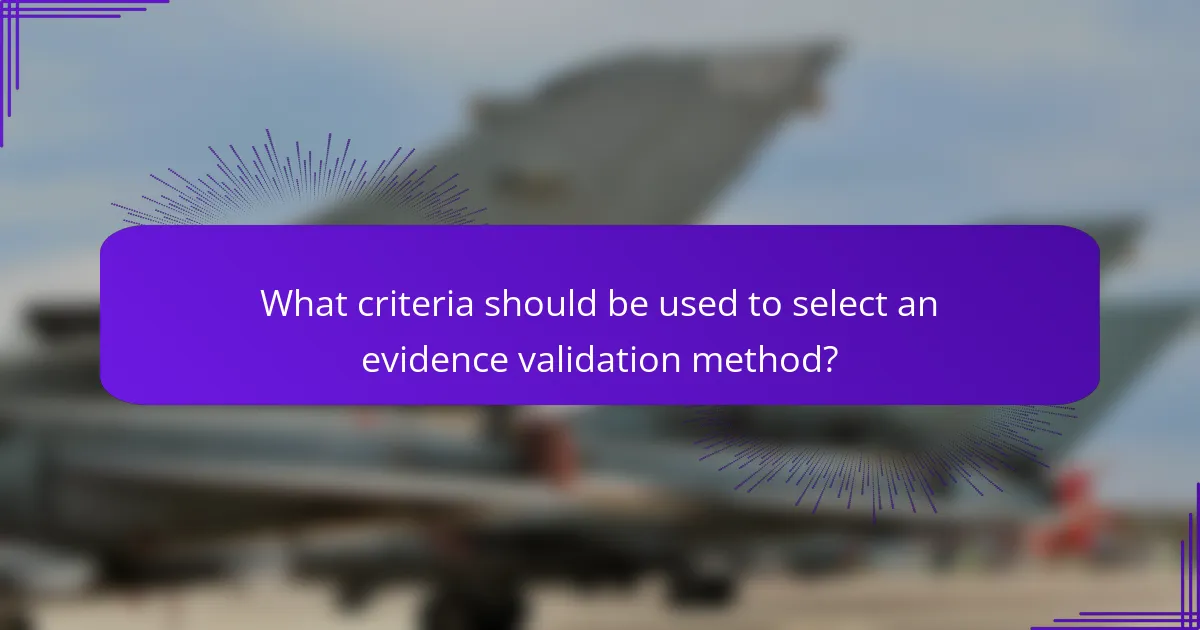
What criteria should be used to select an evidence validation method?
Selecting an evidence validation method requires careful consideration of several key criteria, including the specific research objectives, available resources, and the target audience. These factors will help determine the most effective approach for validating evidence in a given context.
Research objectives
Clearly defined research objectives are crucial when choosing an evidence validation method. Consider whether the goal is to assess the reliability, relevance, or applicability of the evidence. For instance, if the objective is to validate clinical trial data, methods like systematic reviews or meta-analyses may be appropriate.
Additionally, prioritize the type of evidence needed. Qualitative methods may be better suited for exploratory research, while quantitative methods can provide statistical validation. Aligning the validation method with the research objectives ensures that the evidence meets the intended purpose.
Available resources
The resources at your disposal, including time, budget, and personnel, significantly influence the selection of an evidence validation method. For example, a limited budget may restrict the use of extensive data collection techniques, making simpler methods like expert reviews more feasible.
Evaluate the expertise of your team as well. If your team lacks statistical analysis skills, it may be prudent to choose a method that requires less complex analysis. Always consider the trade-offs between thoroughness and practicality based on available resources.
Target audience
Understanding the target audience is essential for selecting an appropriate evidence validation method. Different audiences may have varying levels of expertise and expectations regarding evidence quality. For instance, policymakers may require concise summaries of evidence, while academic audiences might expect detailed methodologies and comprehensive data.
Tailor the validation method to meet the needs of the audience. If the audience is non-technical, consider using simpler validation approaches that communicate findings effectively without overwhelming them with complex data. Engaging the target audience early in the process can also guide the selection of the most relevant validation method.
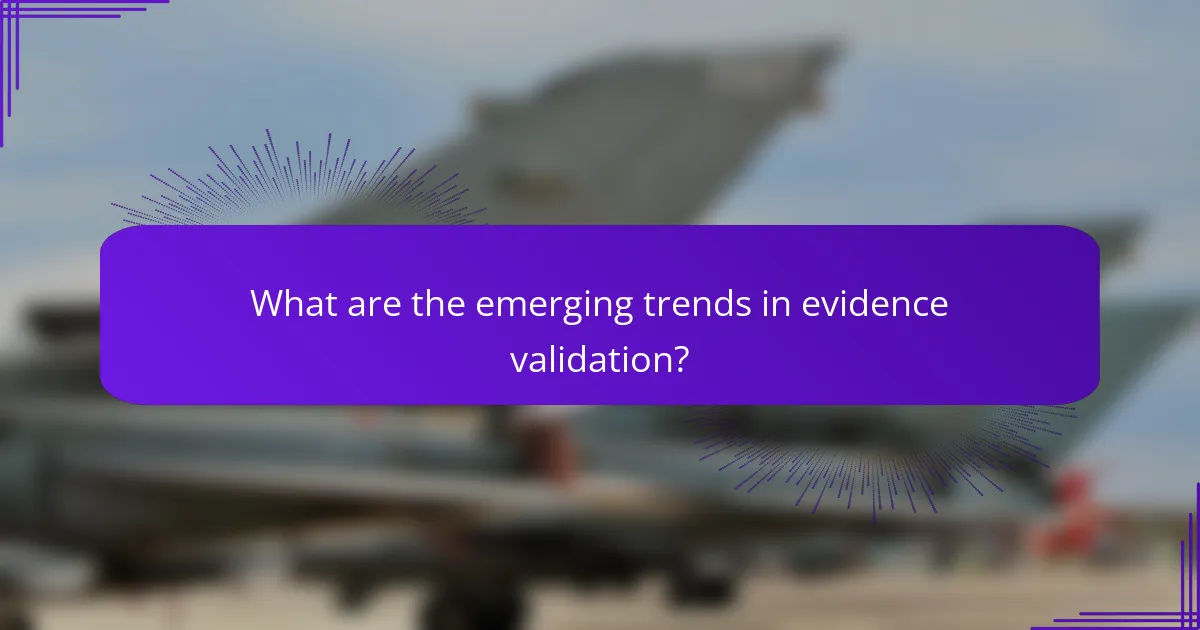
What are the emerging trends in evidence validation?
Emerging trends in evidence validation focus on enhancing accuracy, efficiency, and transparency in the validation process. Innovations such as automated tools, machine learning algorithms, and blockchain technology are reshaping how evidence is verified and authenticated across various fields.
Automation in Evidence Validation
Automation is increasingly being adopted in evidence validation to streamline processes and reduce human error. Automated systems can rapidly analyze large datasets, flag inconsistencies, and provide real-time feedback, which enhances both speed and reliability.
For instance, in legal contexts, automated document review tools can sift through thousands of documents to identify relevant evidence, significantly cutting down the time required for manual reviews. However, it is crucial to ensure that these systems are properly calibrated to avoid false positives or negatives.
Machine Learning Applications
Machine learning is revolutionizing evidence validation by enabling systems to learn from data patterns and improve over time. These algorithms can identify anomalies and predict the likelihood of evidence authenticity based on historical data.
In healthcare, for example, machine learning models can analyze clinical trial data to validate the effectiveness of new treatments. Organizations should invest in high-quality training data to enhance the accuracy of these models and avoid biases that could skew results.
Blockchain for Transparency
Blockchain technology is gaining traction in evidence validation due to its ability to provide a secure and immutable record of transactions. This transparency is particularly valuable in sectors like finance and supply chain management, where trust is paramount.
By using blockchain, organizations can create a tamper-proof ledger of evidence that can be accessed and verified by all stakeholders. However, implementing blockchain solutions requires careful consideration of costs and technical expertise to ensure effective deployment.
